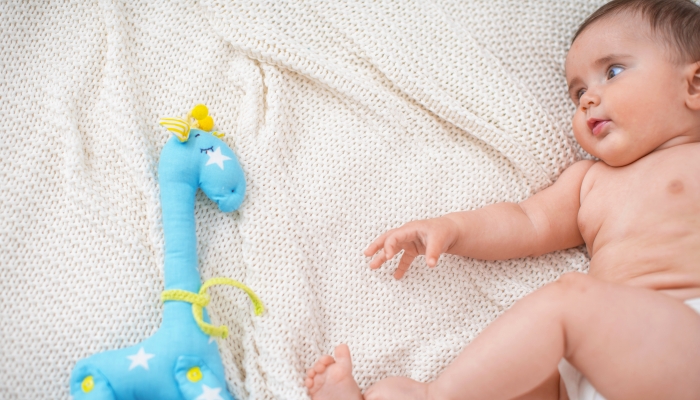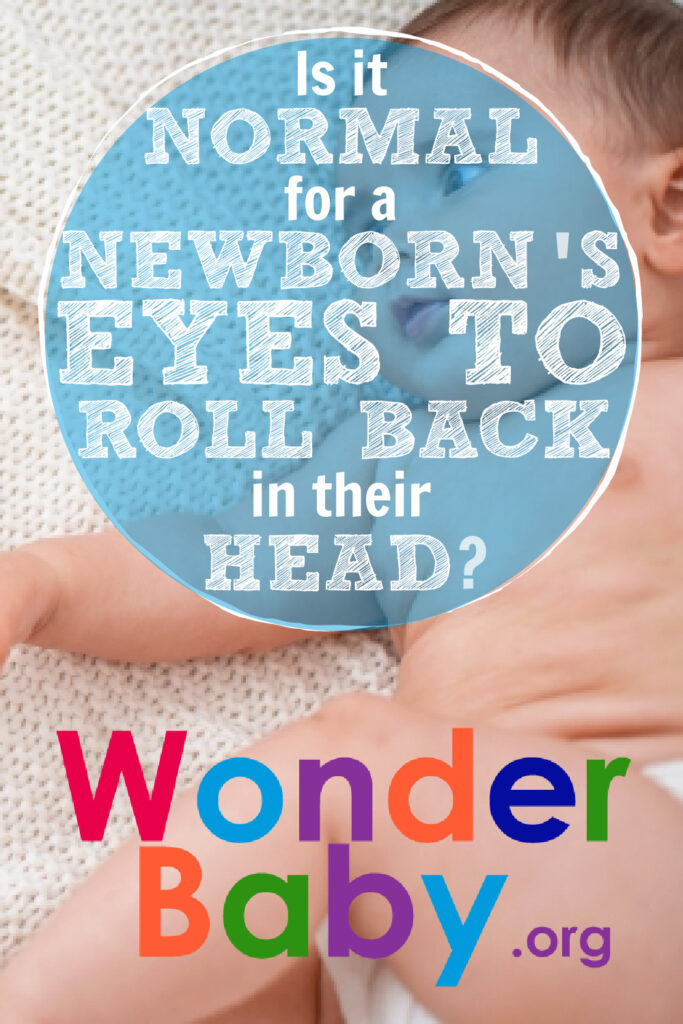Is It Normal for a Newborn’s Eyes to Roll Back in Their Head?

- The vision of newborns continues to develop in their first weeks of life and you may notice different kinds of eye movements, including rolling eyes.
- It is common for newborns to roll their eyes back when they are sleepy or about to fall asleep.
- Sometimes rolling eyes and other eye movement can be symptoms of eye problems or warning signs of seizure, so parents need to pay attention to their newborn’s eyes.
There are so many things to learn about newborns. You count dirty diapers and write down feeding times to make sure they’re getting enough milk. You look up techniques for swaddling so they can sleep. You run for your phone to search online for the term, “Is it normal for ______,” and then fill in the blank with any number of things your baby is or isn’t doing.
One of those things might be your newborn’s rolling eyes. As infant vision develops, their eye movement changes. If your newborn’s eyes roll back in their head how do you know if it’s something to worry about or just one of those things that babies do?
It may help to learn about newborn vision so you can tell the difference between completely normal baby rolling eyes that are part of sleep and eye rolls that are noticeable symptoms of a health condition.
Eye-Rolling in Newborns: What Does It Mean?
Newborn vision is still developing in the first few weeks. According to the American Academy of Ophthalmology, newborns are sensitive to bright light. Although they can see across a room, they prefer to focus on objects and faces that are close to them.
Babies at this early stage are attracted by large shapes and they can see patterns in a range of light and dark. Within the first month, they start to detect colors.
In their first two months, your newborn’s eye movement may seem a little haphazard. That’s because the human eye is complex, and infant eyes are just not well coordinated yet.
Newborn eyes may move in different directions, wander to the sides, or appear to cross. This type of eye movement is normal for most babies and usually self-corrects.
Around three months, as eye muscles strengthen and your baby gets better at focusing, they should be able to track objects as they move.
These early months are when babies are attracted to black and white images and stimulated by monochrome toys and books.

Normal Causes of Eye-Rolling in Newborns
Until about six months, your baby may roll eyes or have unusual eye movement because their eyes are still maturing. It takes time for their eyes to fully mature and work together to focus, track, and recognize familiar objects and people.
When they are awake you may see your baby’s eyes roll back under heavy eyelids as they are waking up or as they are falling asleep. These are normal eye movements in conjunction with yawning and stretching as a sign your baby wants to sleep.
Babies spend much of their sleep in what is called active sleep where they may groan, cry, breathe loudly, or roll their eyes. When your baby is in the rapid eye movement (REM) stage of deep sleep, you might be able to see their eyes rolling under their eyelids. This is completely normal and something that all of us do when sleeping.
Medical Conditions Often Associated With Abnormal Eye-Rolling
Eye rolling while awake that is not associated with sleep can be an indicator of some medical conditions. If you notice your baby roll their eyes a lot while awake or you see other eye movements that worry you, you should see your pediatrician.
The following conditions often have abnormal eye-rolling as a symptom:
Nystagmus
Nystagmus is a condition often detected in early infancy. Excessive eye rolling may be an indicator of nystagmus. The eyes move involuntarily in a repetitive side to side, up and down, or in a circular motion.
The condition can be inherited or acquired in later life as the result of another medical problem, like a stroke. Nystagmus results in some visual loss, difficulty with coordination, and difficulty with reading print. Nystagmus may also be a symptom of other retinal disorders, like Leber’s Congenital Amaurosis (LCA).
Glasses and surgery are not very effective in treating nystagmus. Children with nystagmus will need support and low vision adaptive measures, like good lighting and large print materials in the classroom, but they can lead active lives.
Strabismus
When eyes don’t line up, move in different directions, or wander, these symptoms accompany strabismus, also known as “lazy eye.” The straighter eye becomes dominant and the weaker eye tends to move differently.
If after the age of six months, babies roll their eyes a lot or their eyes continue to move differently from one another, these may be signs of strabismus.
Strabismus can be corrected if found early. Most children are diagnosed between the age of one and four years old.
Cerebral Palsy
Strabismus is often associated with cerebral palsy. While not all children with cerebral palsy will have vision problems, they can be a part of the condition.
Cerebral palsy is diagnosed between 12 and 24 months. Other signs of the condition in babies include:
- Missing developmental milestones like sitting and rolling and holding up head
- Unusually floppy or unusually stiff arms, legs and neck
- Limbs cross over each other
- Favoring one side of the body over the other
- Pushing their body away from you when picked up
If you notice eye-rolling that concerns you or any of these other symptoms in your infant, you should consult with your pediatrician.

When Should Newborn Eye-Rolling Be a Cause of Concern?
Other possible causes of eye-rolling that are not associated with sleeping include head injuries and different kinds of seizures. It is important for all parents to know the signs of a seizure and to talk to their doctor if they are ever concerned.
Febrile Seizure
This kind of seizure is caused by a fever and can happen to any child. They are frightening to witness, but they are usually harmless and last only a few seconds.
Symptoms that accompany febrile seizures are:
- Eyes rolling back in the head
- A fever of 100.4 degrees F (38 degrees C)
- Limb stiffening and jerky body movements
- Loss of consciousness
Although they may be brief, your child should be seen by a doctor in the emergency room after having one of these seizures. It is especially important to seek medical care if the episode lasts longer than five minutes or if your child is vomiting, has irregular breathing, or has a stiff neck.
Other Types of Seizures
Your baby’s eye-rolling could be a sign of other kinds of seizures along with symptoms like excessive irritability and infantile spasms, which are also known as West Syndrome. Make sure to raise any concerns you have with your healthcare provider as soon as possible if you notice these symptoms.

The information WonderBaby provides is not intended to be, and does not constitute, medical or other health advice or diagnosis and should not be used as such. Always consult with a qualified medical professional about your specific circumstances.
Related Posts

Eye Conditions and Syndromes, Visual Impairment
Neuralink Announces Plans to Restore Sight to the Blind with Brain Chip
Elon Musk’s company Neuralink has announced plans to begin human trials of its new “Blindsight” brain chip by the end of 2025.

Health & Nutrition
Can Baby Skin Care Products Expire?
Is that forgotten tube of diaper rash cream still safe to use? Learn more about the expiration dates of popular skin care products for infants.

Health & Nutrition
Boosting Immunity in Kids: 3 Tips for a Healthy Winter
Parents can help boost their kids’ immunity during cold and flu season by maintaining healthy eating, sleeping, and exercising habits in the winter.